 |
|
|
| (Information by Peter Kessler, with additional information by Edward Dawson and Trish Wilson, from The Cambridge Historical Encyclopaedia of Great Britain and Ireland, Christopher Haigh (Ed), from The Oxford History of England: Roman Britain, Peter Salway, from The Oxford History of England: The English Settlements, J N L Meyers, from The Oxford History of England: Anglo-Saxon England, Sir Frank Stenton, from the Historia Brittonum (The History of the Britons), Nennius (J A Giles, Ed & Trans, 1841, published as part of Six Old English Chronicles (Henry G Bohn, London, 1848)), from the Life of St Germanus of Auxerre, Constantius of Lyon, from The Anglo-Saxon Chronicles, Anne Savage (translator and collator, Guild Publishing, 1983), and from A History of the English Church and People, The Venerable Bede (Leo Sherley-Price translation - revised by R E Latham).) |
|
|
| c.420s - 430s |
In the first half of the century there is a second settlement of barbarians in or around the civitas. Again they are probably laeti who are added to the city's defensive forces now that the presence of Roman troops is a thing of the past (although ex-Roman army troops almost certainly remain in places, dedicated to defending their homes and families rather than owing any loyalty to the now-distant empire). 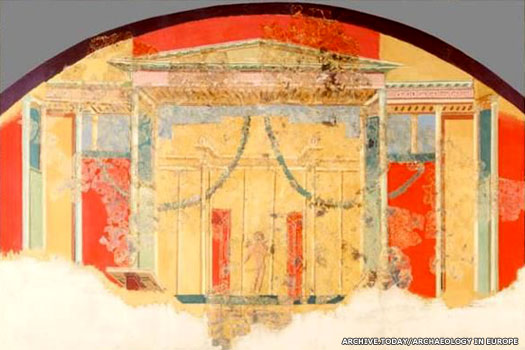 A wall painting in the Roman palace of Venta Belgarum as reconstructed by Sean A MacKenna (1932-2012), an expert in excavation, conservation, structure, and restoration A wall painting in the Roman palace of Venta Belgarum as reconstructed by Sean A MacKenna (1932-2012), an expert in excavation, conservation, structure, and restoration |
|
| This time the new arrivals are from continental Central Europe, almost certainly Saxons. Their pottery in the city antedates the arrival of the general wave of Saxon invaders by over a century. |
|
|
| fl 440s |
Elafius / Elaf? |
Magistrate? Recorded by St Germanus. |
| 446 |
 St Germanus' second visit to Britain sees off the last of the Pelagians and confirms Elafius' subjects in the Catholic faith of the Roman Church. Elafius himself is clearly a Pelagian supporter until the visit, and by inference may be a supporter of Vortigern's pro-Celtic faction in Britain (see feature link). Germanus goes on to restore Cadell Ddyrnllwg to control of the Paganes in the West Midlands. St Germanus' second visit to Britain sees off the last of the Pelagians and confirms Elafius' subjects in the Catholic faith of the Roman Church. Elafius himself is clearly a Pelagian supporter until the visit, and by inference may be a supporter of Vortigern's pro-Celtic faction in Britain (see feature link). Germanus goes on to restore Cadell Ddyrnllwg to control of the Paganes in the West Midlands. |
|
| c.450 - 455 |
Jutes from the Cantware group of invaders, or related to them, settle to the west of modern Southampton, while the Meonware (more Jutes) settle to the immediate east of Southampton Water, possibly threatening the territory's southern border. 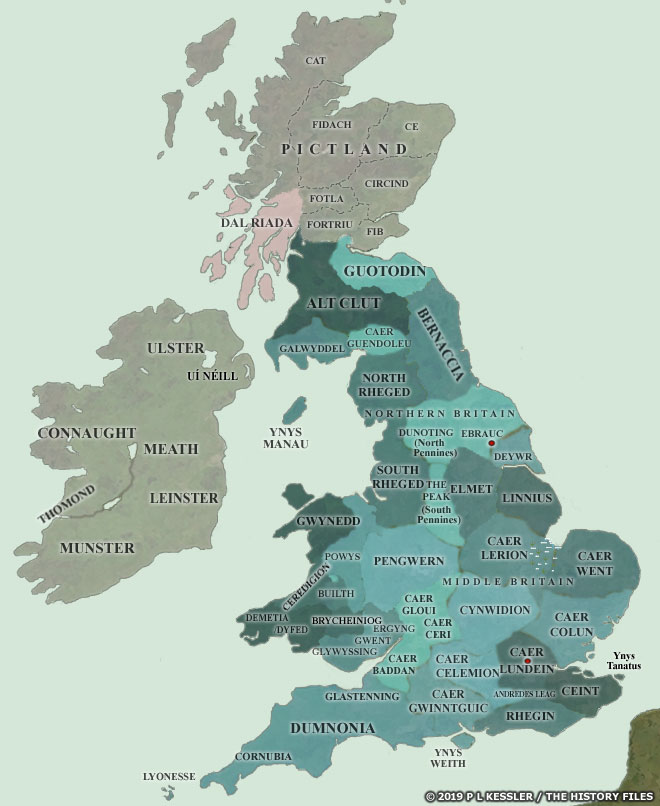 This map of Britain concentrates on British territories and kingdoms which were established during the fourth and fifth centuries AD, as the Saxons and Angles began their settlement of the east coast (click or tap on map to view full sized) This map of Britain concentrates on British territories and kingdoms which were established during the fourth and fifth centuries AD, as the Saxons and Angles began their settlement of the east coast (click or tap on map to view full sized) |
|
| They absorb, or are absorbed by, elements of the Saxon laeti who have been there since the beginning of the century and perhaps because of this integration with settled Saxons and indigenous Britons, they establish peaceful relations with Venta Belgarum. Further settlements are established on Inis Vectis, which may have been a possession of the Belgae prior to the Roman invasion, and may still be dominated by their descendants who now gain a new layer of ruling aristocracy. |
|
|
| 477 |
Newly arrived Saxons under Ælle land at Selsey on the south coast (modern West Sussex) and beat off the Britons of Rhegin who oppose their landing, driving them to take refuge in the great forest called Andredesleag (The Weald). Suddenly, though, the southern Saxon Shore has been breached in a far more major way than the arrival of the Meonware had threatened, and Venta Belgarum is mainly cut off from the south coast. By this time the economic basis for the city's existence has disappeared. Its population has dwindled and the remaining inhabitants are developing a siege mentality in the face of increasing Saxon encroachment from the east. 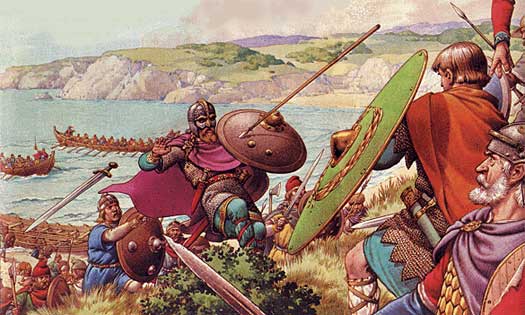 The coming of Ælle and his apparently pre-established status as bretwalda spelled eventual defeat and death for the Britons of modern Sussex, and quite possibly led to the siege of Mons Badonicus The coming of Ælle and his apparently pre-established status as bretwalda spelled eventual defeat and death for the Britons of modern Sussex, and quite possibly led to the siege of Mons Badonicus |
|
| 480s - 490s |
 This is the probable period in which the traditional twelve victorious battles of Arthur are fought (see feature link). In reality, although many of the battles seem to reflect actual events, it is likely that they are spaced out over a greater length of time, and are undertaken by multiple British leaders (most especially Ambrosius Aurelianus). One of those battles takes place at the fort of Guinnion (linked to Venta Belgarum). If invading Saxons have managed to penetrate this far inland then it may be a shocking occurrence. Alternatively it could instead be a revolt by Germanic laeti who are already settled in the region... or possibly an early effort by the infamous Cerdic (see below). This is the probable period in which the traditional twelve victorious battles of Arthur are fought (see feature link). In reality, although many of the battles seem to reflect actual events, it is likely that they are spaced out over a greater length of time, and are undertaken by multiple British leaders (most especially Ambrosius Aurelianus). One of those battles takes place at the fort of Guinnion (linked to Venta Belgarum). If invading Saxons have managed to penetrate this far inland then it may be a shocking occurrence. Alternatively it could instead be a revolt by Germanic laeti who are already settled in the region... or possibly an early effort by the infamous Cerdic (see below). |
|
| ? - 495? |
Cerdic / Caraticos? |
Possible Belgae magistrate before conquering West Seaxe? |
| c.495 - c.525 |
The south gate of Venta is blocked in two stages, possibly in response to the settlement of the Meonware or more probably due to the founding of Cerdic's kingdom which eventually becomes that of the West Seaxe. The territory's defences force the West Seaxe to consolidate within a certain area, as they are bottled up towards the west by Dumnonia. However, the settlement at Clavsentum (Bitterne), close to the Solent, has been lost. In fact, given the reasonable probability that Cerdic himself is of noble British birth and may hold a position of authority in the country, he could well be a magistrate of the Belgae prior to his rebellion in 495. 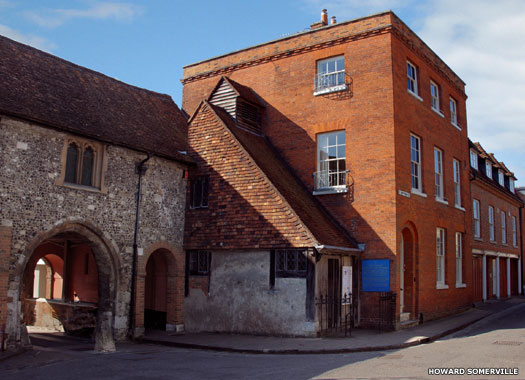 The medieval King's Gate in Winchester (Venta) was built over the site of the Roman south gate in the year 1264, almost eight hundred years after the original was blocked up by its defending Romano-British-Saxon population The medieval King's Gate in Winchester (Venta) was built over the site of the Roman south gate in the year 1264, almost eight hundred years after the original was blocked up by its defending Romano-British-Saxon population |
|
| The possible variation of his name as it is recorded by the Anglo-Saxon Chronicle is Caraticos, another form of the Celtic name 'Cara Tog' or 'Cara Tag -os', meaning 'beloved of/dear to the god Togo/Tag/Dagda'. By this time the city has become isolated from Dumnonia in the west, and Rhegin to the south-east has already fallen, so Venta's world is narrowing. The Romano-British population is much reduced from a century before, with many probably having migrated west while they still could. The core population which remains could well be balanced equally between Romano-British warriors and their families and the Romano-Saxon laeti and their families (given that at least some of the latter have been there for up to six generations). It is probably in this period that the territory's name of Gwinntguic replaces the city's name of Venta, as explained in the introduction. |
|
|
| ? - 508 |
Natan / Natanlaod / Nudd? |
A commander. Magistrate? Killed by the West Seaxe. |
| 508 |
 Cerdic'sWest Seaxe defeat Natanlaod's Britons in the area of Southampton Water. Could Natanleod be a rival British chieftain or Roman-style official (perhaps of Caer Gwinntguic) who is vying for power with Cerdic or attempting to defend Britain's shores (see feature link)? Cerdic'sWest Seaxe defeat Natanlaod's Britons in the area of Southampton Water. Could Natanleod be a rival British chieftain or Roman-style official (perhaps of Caer Gwinntguic) who is vying for power with Cerdic or attempting to defend Britain's shores (see feature link)? 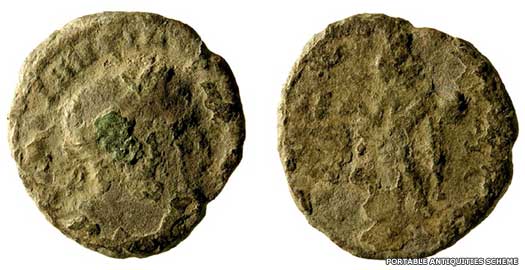 The Jutes of Wight and Hampshire appear to have maintained trading links with the Byzantines, as findings in both areas have attested. These Byzantine coins were part of a scattering of thirty-five found on the Isle of Wight The Jutes of Wight and Hampshire appear to have maintained trading links with the Byzantines, as findings in both areas have attested. These Byzantine coins were part of a scattering of thirty-five found on the Isle of Wight |
|
| Having established a beachhead and killed the (possibly) legitimate governor or ruler, Cerdic may be the only hope in the region for strong governance, with the result that Britons, Saxons, and Jutes join him. The victory probably completes Gwinntguic's isolation from the very south coast which it had been expected to protect. |
|
|
| 552 |
Caer Gwinntguic falls to the West Seaxe, making its northern neighbour, Caer Celemion, very vulnerable on its less well-defended southern border. The city is not fully abandoned. The Saxons who have lived there since the early fifth century and even before that probably remain, perhaps even with the surviving Romano-Britons.  The two groups are virtually kin by now, and certainly closer in relation to each other than they are to their conquerors. In time the city becomes Wintanceastre (Winchester), capital of the West Seaxe kingdom from 590, and the seat of the bishop of Wessex from 676 (see feature link). The two groups are virtually kin by now, and certainly closer in relation to each other than they are to their conquerors. In time the city becomes Wintanceastre (Winchester), capital of the West Seaxe kingdom from 590, and the seat of the bishop of Wessex from 676 (see feature link). |
|
 |
|
|
 With the expulsion of Roman officials in AD 409 (see feature link), Britain again became independent of Rome and was not re-occupied. The fragmentation which had begun to emerge towards the end of the fourth century now appears to have accelerated, with minor princes, newly declared kings, and Roman-style magistrates all vying for power and influence while also facing the threat of extinction at the hands of the various barbarian tribes which were encroaching from all sides. [
With the expulsion of Roman officials in AD 409 (see feature link), Britain again became independent of Rome and was not re-occupied. The fragmentation which had begun to emerge towards the end of the fourth century now appears to have accelerated, with minor princes, newly declared kings, and Roman-style magistrates all vying for power and influence while also facing the threat of extinction at the hands of the various barbarian tribes which were encroaching from all sides. [  ](../FeaturesBritain/BritishSouthernBritain04.htm#Caer Gwinntguic)From its regional capital at the Roman town of Venta Belgarum (Winchester in Hampshire), the British territory of the Belgae seems to have reasserted some degree of independence in the early fifth century. The territory shared a long northern border with Caer Celemion, and also bordered Rhegin to the south-east, Inis Vectis (Isle of Wight) to the south, Dumnonia to the west, and Caer Baddan to the north-west (see feature link). The region was tasked with defending the westernmost section of the Saxon Shore in the fifth century, and Saxon laeti were probably hired and settled on the south coast for this very reason, arriving in the first half of the fifth century (archaeology confirms this). Their role may have become important in the territory's later years, either as a key part of its defence or as its later enemy (either way, it seems that they may have played a role in forming the name used here, Caer Gwinntguic). In the mid-fifth century it seems that the political situation suddenly changed. British central authority was locked in civil war, and the country was struck by plague and subjected to a barbarian sacking from coast to coast. Sacking swiftly turned to partial conquest, and areas of the south coast were settled by Jutes who called themselves the Meonware. This would have been all-too-close for Venta Belgarum.
](../FeaturesBritain/BritishSouthernBritain04.htm#Caer Gwinntguic)From its regional capital at the Roman town of Venta Belgarum (Winchester in Hampshire), the British territory of the Belgae seems to have reasserted some degree of independence in the early fifth century. The territory shared a long northern border with Caer Celemion, and also bordered Rhegin to the south-east, Inis Vectis (Isle of Wight) to the south, Dumnonia to the west, and Caer Baddan to the north-west (see feature link). The region was tasked with defending the westernmost section of the Saxon Shore in the fifth century, and Saxon laeti were probably hired and settled on the south coast for this very reason, arriving in the first half of the fifth century (archaeology confirms this). Their role may have become important in the territory's later years, either as a key part of its defence or as its later enemy (either way, it seems that they may have played a role in forming the name used here, Caer Gwinntguic). In the mid-fifth century it seems that the political situation suddenly changed. British central authority was locked in civil war, and the country was struck by plague and subjected to a barbarian sacking from coast to coast. Sacking swiftly turned to partial conquest, and areas of the south coast were settled by Jutes who called themselves the Meonware. This would have been all-too-close for Venta Belgarum.  The origins of the Gwinntguic name can be broken down as follows, by pointing out the fact that 'gwinnt' (or more usually 'gwent') is a typical late pronunciation of 'venta'. As for 'guic', there was a strong Celtic habit of transforming a 'w' into a 'gw' or 'gu'. One very well known example of this is the Votadini tribe. That name underwent a fairly standard alteration from 'v' (or sometimes 'w') to 'gu' and then to 'g'. In the case of '-guic', this starts with 'gu'. Take off the older 'g' sound and it becomes 'wic', which was well known in Anglo-Saxon English as a trading centre (such as Ipswich (see feature link), Norwich, Lundenwic, and Hamptonwic - now Southampton). Saxons were often settled just outside the walls of any city which they were being hired to protect. They would have obtained their food and goods from the city's traders and, in the case of Venta Belgarum - and perhaps only speaking a little Latin - could have pronounced 'Gwent' or 'Gwinnt' as 'Went-', and added 'wic' to produce 'Wentawic'.
The origins of the Gwinntguic name can be broken down as follows, by pointing out the fact that 'gwinnt' (or more usually 'gwent') is a typical late pronunciation of 'venta'. As for 'guic', there was a strong Celtic habit of transforming a 'w' into a 'gw' or 'gu'. One very well known example of this is the Votadini tribe. That name underwent a fairly standard alteration from 'v' (or sometimes 'w') to 'gu' and then to 'g'. In the case of '-guic', this starts with 'gu'. Take off the older 'g' sound and it becomes 'wic', which was well known in Anglo-Saxon English as a trading centre (such as Ipswich (see feature link), Norwich, Lundenwic, and Hamptonwic - now Southampton). Saxons were often settled just outside the walls of any city which they were being hired to protect. They would have obtained their food and goods from the city's traders and, in the case of Venta Belgarum - and perhaps only speaking a little Latin - could have pronounced 'Gwent' or 'Gwinnt' as 'Went-', and added 'wic' to produce 'Wentawic'.  Extending the hypothesis a little further, the locals could have picked up on the Saxon variation of the city's name and adopted it, perhaps in the later days when virtually all outside communication had been cut off and the Romano-Britons and Saxons were now brothers-in-arms who were on an equal footing. Perhaps the Saxons had even integrated enough to be classed as Romano-Saxons. The recycled name of the city could have been rendered by its occupants as 'wenta wic', or 'gwent gwic' and adopted as such by later writers. The Historia Brittonum labels the city Caer Guin Truis (see feature link). Also worth noting is the fact that the Brythonic language has gone through five stages to reach modern Welsh: 'Primitive' (in the 500s-700s), Old Welsh (in the 800s-1000s), Middle Welsh (in the 1100s-1400s), 'Early Modern' (in the 1400s-1700s), and 'Late Modern' thereafter. Until the Middle Welsh period, the word 'caer' was actually 'cair', from the Brythonic 'cajr', meaning 'fort, fortified place'.
Extending the hypothesis a little further, the locals could have picked up on the Saxon variation of the city's name and adopted it, perhaps in the later days when virtually all outside communication had been cut off and the Romano-Britons and Saxons were now brothers-in-arms who were on an equal footing. Perhaps the Saxons had even integrated enough to be classed as Romano-Saxons. The recycled name of the city could have been rendered by its occupants as 'wenta wic', or 'gwent gwic' and adopted as such by later writers. The Historia Brittonum labels the city Caer Guin Truis (see feature link). Also worth noting is the fact that the Brythonic language has gone through five stages to reach modern Welsh: 'Primitive' (in the 500s-700s), Old Welsh (in the 800s-1000s), Middle Welsh (in the 1100s-1400s), 'Early Modern' (in the 1400s-1700s), and 'Late Modern' thereafter. Until the Middle Welsh period, the word 'caer' was actually 'cair', from the Brythonic 'cajr', meaning 'fort, fortified place'.
 A wall painting in the Roman palace of Venta Belgarum as reconstructed by Sean A MacKenna (1932-2012), an expert in excavation, conservation, structure, and restoration
A wall painting in the Roman palace of Venta Belgarum as reconstructed by Sean A MacKenna (1932-2012), an expert in excavation, conservation, structure, and restoration St Germanus' second visit to Britain sees off the last of the Pelagians and confirms Elafius' subjects in the Catholic faith of the Roman Church. Elafius himself is clearly a Pelagian supporter until the visit, and by inference may be a supporter of Vortigern's pro-Celtic faction in Britain (see feature link). Germanus goes on to restore Cadell Ddyrnllwg to control of the Paganes in the West Midlands.
St Germanus' second visit to Britain sees off the last of the Pelagians and confirms Elafius' subjects in the Catholic faith of the Roman Church. Elafius himself is clearly a Pelagian supporter until the visit, and by inference may be a supporter of Vortigern's pro-Celtic faction in Britain (see feature link). Germanus goes on to restore Cadell Ddyrnllwg to control of the Paganes in the West Midlands. This map of Britain concentrates on British territories and kingdoms which were established during the fourth and fifth centuries AD, as the Saxons and Angles began their settlement of the east coast (click or tap on map to view full sized)
This map of Britain concentrates on British territories and kingdoms which were established during the fourth and fifth centuries AD, as the Saxons and Angles began their settlement of the east coast (click or tap on map to view full sized) The coming of Ælle and his apparently pre-established status as bretwalda spelled eventual defeat and death for the Britons of modern Sussex, and quite possibly led to the siege of Mons Badonicus
The coming of Ælle and his apparently pre-established status as bretwalda spelled eventual defeat and death for the Britons of modern Sussex, and quite possibly led to the siege of Mons Badonicus This is the probable period in which the traditional twelve victorious battles of Arthur are fought (see feature link). In reality, although many of the battles seem to reflect actual events, it is likely that they are spaced out over a greater length of time, and are undertaken by multiple British leaders (most especially Ambrosius Aurelianus). One of those battles takes place at the fort of Guinnion (linked to Venta Belgarum). If invading Saxons have managed to penetrate this far inland then it may be a shocking occurrence. Alternatively it could instead be a revolt by Germanic laeti who are already settled in the region... or possibly an early effort by the infamous Cerdic (see below).
This is the probable period in which the traditional twelve victorious battles of Arthur are fought (see feature link). In reality, although many of the battles seem to reflect actual events, it is likely that they are spaced out over a greater length of time, and are undertaken by multiple British leaders (most especially Ambrosius Aurelianus). One of those battles takes place at the fort of Guinnion (linked to Venta Belgarum). If invading Saxons have managed to penetrate this far inland then it may be a shocking occurrence. Alternatively it could instead be a revolt by Germanic laeti who are already settled in the region... or possibly an early effort by the infamous Cerdic (see below). The medieval King's Gate in Winchester (Venta) was built over the site of the Roman south gate in the year 1264, almost eight hundred years after the original was blocked up by its defending Romano-British-Saxon population
The medieval King's Gate in Winchester (Venta) was built over the site of the Roman south gate in the year 1264, almost eight hundred years after the original was blocked up by its defending Romano-British-Saxon population Cerdic'sWest Seaxe defeat Natanlaod's Britons in the area of Southampton Water. Could Natanleod be a rival British chieftain or Roman-style official (perhaps of Caer Gwinntguic) who is vying for power with Cerdic or attempting to defend Britain's shores (see feature link)?
Cerdic'sWest Seaxe defeat Natanlaod's Britons in the area of Southampton Water. Could Natanleod be a rival British chieftain or Roman-style official (perhaps of Caer Gwinntguic) who is vying for power with Cerdic or attempting to defend Britain's shores (see feature link)?  The Jutes of Wight and Hampshire appear to have maintained trading links with the Byzantines, as findings in both areas have attested. These Byzantine coins were part of a scattering of thirty-five found on the Isle of Wight
The Jutes of Wight and Hampshire appear to have maintained trading links with the Byzantines, as findings in both areas have attested. These Byzantine coins were part of a scattering of thirty-five found on the Isle of Wight The two groups are virtually kin by now, and certainly closer in relation to each other than they are to their conquerors. In time the city becomes Wintanceastre (Winchester), capital of the West Seaxe kingdom from 590, and the seat of the bishop of Wessex from 676 (see feature link).
The two groups are virtually kin by now, and certainly closer in relation to each other than they are to their conquerors. In time the city becomes Wintanceastre (Winchester), capital of the West Seaxe kingdom from 590, and the seat of the bishop of Wessex from 676 (see feature link).